How to Prevent Cracks In Concrete | Cause of Cracks In Concrete| Shrinkage Cracks In Concrete | Concrete Cracks Repair.
In this Article today we will talk about the How to Prevent Cracks in Concrete | Concrete Cracks Repair | Causes of Cracks in Concrete | Types of Cracks in Concrete | Shrinkage Cracks in Concrete.
Cracks in Concrete | Introduction:
- A crack is a complete or incomplete separation of concrete into two or more parts produced by breaking or fracturing.
- Cracking are early indications of failure of structure. It is vital to note that concrete does crack and this is usual. What is not normal is too much of cracks.
- Cracks affects the building artistic and it also destroys the wall’s integrity, affects the structure’s safety, even reduces the durability of structure.
Cracks can be treated as cancer in R.C.C structure, as cancer which in its primary stage is curable to a certain extent but becomes danger to life in later stage; same happens with cracks
OTHER POSTS:
-
What Is Honeycomb In Concrete | Cause of Honeycomb In Concrete
-
Basic Components of Road Structure and Method of Construction
-
Basic Civil Engineering Knowledge for Freshers – 101 Civil Engg Tips
Classification of Cracks:
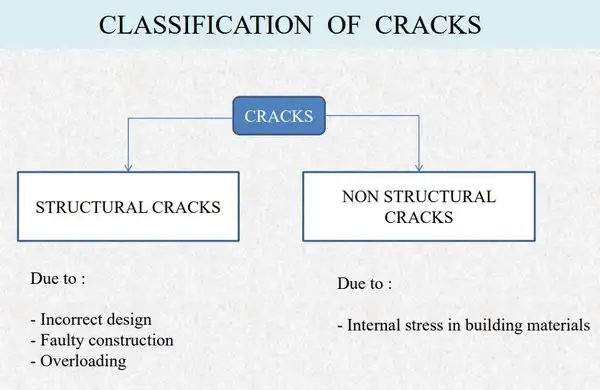
Types of Cracks Based on Hardening of Concrete:
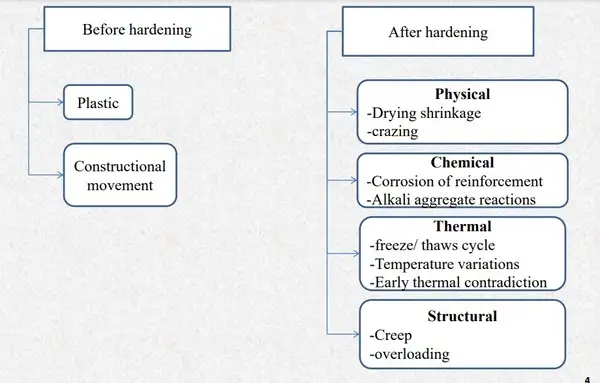
Causes of Cracks and Its Remedies:
Plastic Shrinkage Cracking:
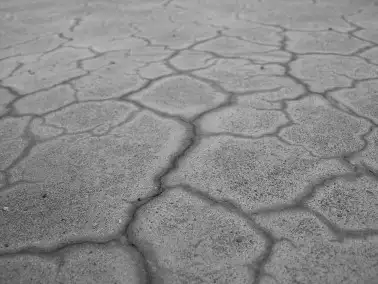
- It arises when the rate of evaporation of water from top layer of freshly laid concrete is greater than bleed water provided by underlying concrete, due to this surface concrete contracts. Prevent Cracks in Concrete
- Due to the restraint shown by the concrete below the drying surface concrete layer the tensile stresses are develop in the weak and stiffening plastic concrete.
- These cracks usually are parallel to one another and are spaced 0.3m to 1m apart. These cracks may be as much as 5cm to 10cm in depth and up to 3mm in width.
Plastic shrinkage cracking occur due to:
- Temperature of air above concrete is high.
- Low relative humidity. Prevent Cracks in Concrete
- Wind velocity above concrete is high.
Preventive measures of plastic shrinkage include use of:
- Styrene Butadiene latex co-polymer as Bonding Agent
- Fog nozzles to saturate the air above concrete
- Plastic sheeting to cover concrete
- Windbreaks to decrease the wind velocity. Concrete Cracks Repair
Drying Shrinkage:
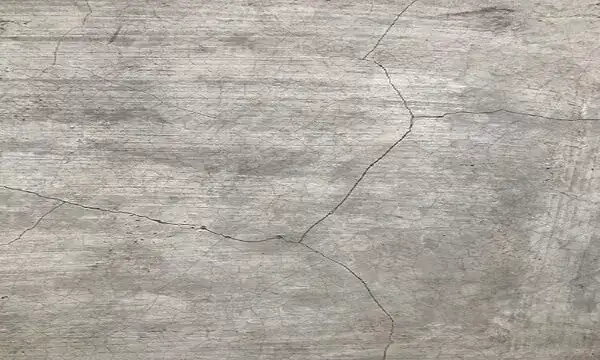
- After hardening, concrete starts drying. The excess water leaves the system causing contraction or shrinkage. This excess water, called water of convenience would have been added to get adequate workability and finish.
- The loss of free water contained in hardened concrete, does not result in any appreciable dimension change. It is the loss of water held in gel pores that causes the change in the volume. Concrete Cracks Repair
- Smaller size of aggregate > finer gel > More shrinkage
Preventive Measures:
- Rigid formwork. Prevent Cracks in Concrete
- Use of acrylic polymer for crack filling and tile joint filling by mixing along with white cement.
- Leak proof formwork. Concrete Cracks Repair
- Use of screed vibrator and float for surface finishing.
- Use of a ‘rich” concrete mix (400 kg/m³ binder, W/C = 0.4) should be encouraged
Concrete Crazing:
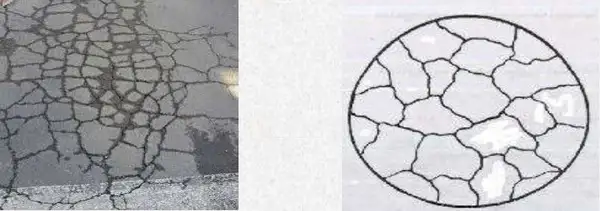
- Crazing is the development of a network of fine random cracks or fissures on the surface of concrete caused by shrinkage of the surface layer.
- These cracks are rarely more than 3mm deep, and are more noticeable on over floated or steel-troweled surfaces.
Causes:
- Poor or inadequate curing.
- Intermittent wet curing and drying.
- Excessive floating.
- Excessive laitance on surface.
- Finishing with float when bleed water is on the surface.
- Sprinkling cement on the surface to dry up the bleed water.
Preventive Measures:
- Proper and early start of curing.
- Use of curing compound on the surface.
- Never sprinkle dry cement or a mixture of cement and fine sand on the surface of the plastic concrete. Causes of Cracks in Concrete
Thermal Variations:
- Temperature difference within a concrete structure may be caused by portions of the structure losing heat of hydration at different rates at one portion of the structure to a different degree or at a different rate than another portion of the structure.
- These temperature differences result in differential volume change, leading to cracks.
- The more massive is the structure, the greater is the potential for temperature differential and restraint. Hardened concrete has a coefficient of thermal expansion that may range from 4 to 9 x 10-6 per deg. F.
Preventive Measures:
- Controlling the rate at which the concrete cools by insulating the exposed concrete surface during first 5 days. Causes of Cracks in Concrete
- Increasing the tensile strength of concrete.
- Reducing the concrete temperature at placement up to say 32 ˚C.
- Using low heat of hydration cement or using fly ash replacement of part of cement.
- Keeping steel formwork warm by air heating during winter.
- Use of thermally insulating material as formwork.
- Low grade of cement, OPC 33 grade is the best.
Cracking Due to Chemical Reaction:
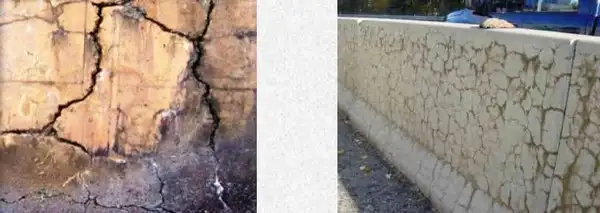
- Deleterious chemical reactions may cause cracking of concrete, due to materials used to make the concrete or materials that come into contact with the concrete after it has hardened. Causes of Cracks in Concrete
- Concrete may crack with time as the result of slowly developing expansive reactions between aggregate containing active silica and alkalis derived from cement hydration, admixtures or external sources.
- Alkali – silica reaction > Formation of gel pores > Local expansion
Preventive Measures:
- Proper selection of aggregate – it should be innocuous to alkalinity.
- Cement with low alkalinity (preferably less than 0.5, IS:456 limit is 0.6).
- Use of Pozzolanas (like fly ash and blast furnace slag) which themselves contain very fine highly active silicon.
Errors in Design and Detailing:
- Poorly detailed re entrant corners in walls, precast members and slabs.
- Restraint to members subjects to volume changes caused by variations in temperature and moisture.
- Lack of adequate contraction joints.
- Improper design of foundations resulting in differential movement within the structure.

Weathering:
- It includes freezing and thawing, wetting and drying and heating and cooling.
- Damage due to freezing and thawing is the most common weather related to physical deterioration.
- Damage in hardened cement paste from freezing is caused by the movement of water to freezing sites and by hydraulic pressure generated by growth of ice crystal.
Preventive Measures:
- Use of lowest practical water cement ratio and total water content
- Durable aggregate
- Adequate air entrainment
- Allowing structure to dry after curing
Poor Construction Practice:
Some poor construction practices that results in cracking are:
- Adding water to improve workability
- Lack of curing
- Inadequate formwork support
- Inadequate compaction
- Placement of construction joints at high stress
Preventive Measures:
- Proper monitoring and use of good quality of materials is required at the time of construction.
Structural Overloads:
- Concrete gets damaged due to structural overload which are very easy to detect. Precast member like beam and are generally subjected to this type of load.
- Most unfortunate things about cracks is due to structural overload are that cracks are detected at early stages.
Preventive Measures:
- These types of cracks can be prevented if designer limit the load on structure.
Foundation Movement and Settlement of Soil:
Shear cracks in buildings occur when there is large differential settlement of foundation and it may be either due to the following reasons:
- Unequal bearing pressure under different parts of the structure.
- Bearing pressure on soil being in excess of safe bearing strength of the soil.
- Low factor of safety in the design of foundation.
- Local variation in the nature of supporting soil.
Preventive Measures:
- The design of foundation should be based on sound engineering principles and good practice. Shrinkage Cracks in Concrete
Vegetation:

- Fast growing trees in the area around the walls can sometimes cause cracks in walls due to expansive action of roots growing under the foundation.
- The cracks occur in clay soil due to moisture contained by roots.
Preventive Measures:
- Do not grow trees too close to the building. Remove any saplings of trees as soon as possible if they start growing in or near of walls.
Conclusion:
Full article on How to Prevent Cracks in Concrete | Concrete Cracks Repair | Causes of Cracks in Concrete | Types of Cracks in Concrete | Shrinkage Cracks in Concrete. Thank you for the full reading of this article in “The Civil Engineering” platform in English. If you find this post helpful, then help others by sharing it on social media. If you have any question regarding article please tell me in comments.


4 Comments
Your message or reports or lectures are good. Many of the topics can be taken as handbook for Engineers
Thanks for the comments please visit more articles by clicking on “All Posts” tab of the Menu Bar
Nice article , keep researching for humanity . You have given good information to engineer community.
Engineer Muhammad Haneef Chief Resident Engineer CRE Nespak Pakistan
Thanks for the comments please visit more articles by clicking on “All Posts” tab of the Menu Bar